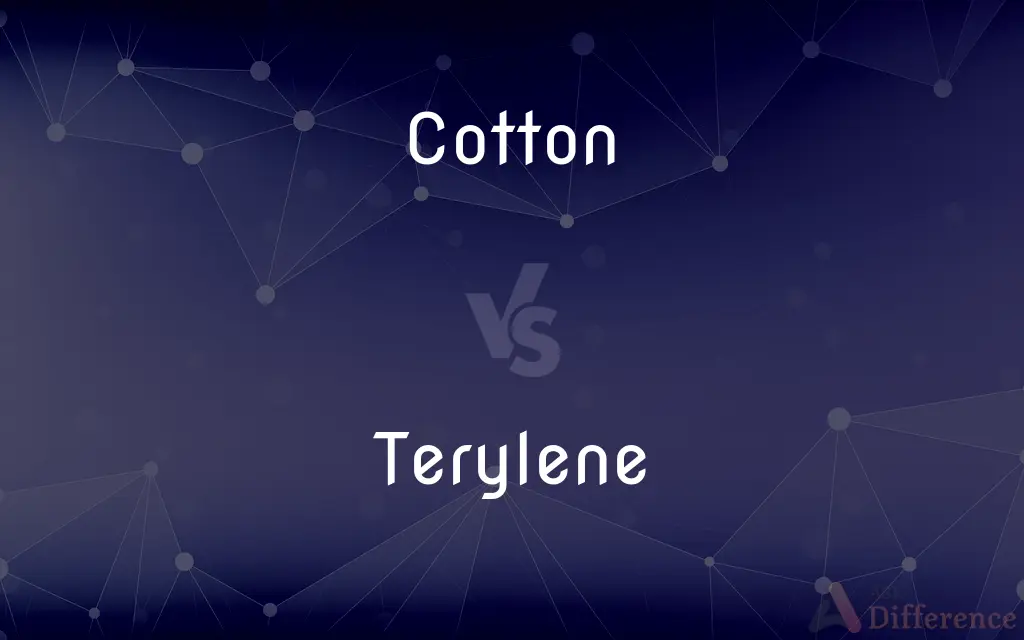Cotton vs. Terylene — What's the Difference?
By Maham Liaqat & Fiza Rafique — Updated on April 1, 2024
Cotton is a natural fiber known for its comfort and breathability, while Terylene, a type of polyester, offers durability and resistance to wrinkles and shrinking.

Difference Between Cotton and Terylene
Table of Contents
ADVERTISEMENT
Key Differences
Cotton, a soft, fluffy staple fiber that grows in a boll around the seeds of cotton plants, is prized for its natural origin, breathability, and softness. It's highly absorbent and comfortable to wear, making it a popular choice for a wide range of clothing, including t-shirts, underwear, and bed linens. Terylene, on the other hand, is a synthetic polyester fiber known for its strength, durability, and resistance to stretching, shrinking, and wrinkling. It is often used in clothing, home furnishings, and industrial applications where durability is required.
One of the main advantages of cotton is its ability to wick moisture away from the body, making it ideal for hot weather and active wear. It's also hypoallergenic and does not irritate the skin, which is beneficial for sensitive skin. Terylene, while less breathable than cotton, has quick-drying properties and maintains its shape well, making it suitable for outdoor clothing and items that need to withstand frequent washing and wear.
In terms of environmental impact, cotton is a renewable resource but its cultivation can be water-intensive and often involves the use of pesticides. Efforts to produce organic cotton aim to reduce these environmental drawbacks. Terylene, being a petroleum-based product, relies on non-renewable resources and its production involves chemical processes, but it has a longer lifespan and can be recycled, which mitigates some environmental concerns.
When it comes to care and maintenance, cotton garments usually require more attention such as ironing and careful washing to avoid shrinkage. Terylene garments, however, are easier to care for due to their resistance to shrinking and wrinkling. They can often be washed and worn with minimal ironing required, which can save time and energy.
The choice between cotton and Terylene depends on the specific needs of the user, including comfort, durability, care requirements, and environmental considerations. While cotton offers natural comfort and breathability, Terylene provides strength, durability, and ease of maintenance.
ADVERTISEMENT
Comparison Chart
Origin
Natural fiber from cotton plants.
Synthetic polyester fiber.
Comfort
Highly breathable and soft.
Less breathable, but soft and maintains shape.
Durability
Prone to wear and tear over time.
Highly durable, resistant to stretching and shrinking.
Care
Requires careful washing and ironing.
Easy care, minimal shrinking and wrinkling.
Environmental Impact
Renewable but water and pesticide intensive.
Petroleum-based, but recyclable.
Compare with Definitions
Cotton
Natural and breathable.
The cotton shirt kept him cool during the summer heat.
Terylene
Resistant to wrinkles.
His Terylene suit remained wrinkle-free throughout the day.
Cotton
Hypoallergenic.
Cotton bedding is recommended for those with sensitive skin.
Terylene
Strong and durable.
Terylene curtains are great for long-lasting use without fading.
Cotton
Requires more care.
The cotton dress needs to be ironed after every wash.
Terylene
Suitable for outdoor use.
Terylene is often used in outdoor furniture covers for its durability.
Cotton
Absorbent and comfortable.
She prefers cotton towels for their softness and absorbency.
Terylene
Easy to care for.
The Terylene tablecloth can be washed and used immediately with no need for ironing.
Cotton
Renewable resource.
Organic cotton farming aims to reduce environmental impact.
Terylene
Quick-drying.
The Terylene sports gear dried quickly after a rain shower.
Cotton
Cotton is a soft, fluffy staple fiber that grows in a boll, or protective case, around the seeds of the cotton plants of the genus Gossypium in the mallow family Malvaceae. The fiber is almost pure cellulose.
Terylene
An artificial textile fibre made from a polyester, used to make light, crease-resistant clothing, bed linen, and sails.
Cotton
Any of various shrubby plants of the genus Gossypium, having showy flowers and grown for the soft white downy fibers surrounding oil-rich seeds.
Terylene
A polymer, polyethylene terephthalate (PET), used for making thread and cloth.
Cotton
The fiber of any of these plants, used in making textiles and other products.
Terylene
A kind of polyester fabric
Cotton
Thread or cloth manufactured from the fiber of these plants.
Cotton
Any of various soft downy substances produced by other plants, as on the seeds of a cottonwood.
Cotton
To take a liking; attempt to be friendly
A dog that didn't cotton to strangers.
An administration that will cotton up to the most repressive of regimes.
Cotton
To come to understand. Often used with to or onto
"The German bosses ... never cottoned to such changes" (N.R. Kleinfield).
Cotton
Gossypium, a genus of plant used as a source of cotton fiber.
Cotton
Any plant that encases its seed in a thin fiber that is harvested and used as a fabric or cloth.
Cotton
Any fiber similar in appearance and use to Gossypium fiber.
Cotton
(textiles) The textile made from the fiber harvested from a cotton plant, especially Gossypium.
Cotton
(countable) An item of clothing made from cotton.
Cotton
Made of cotton.
Cotton
(transitive) To provide with cotton.
Cotton
To supply with a cotton wick.
Cotton
To fill with a wad of cotton.
Cotton
(horticulture) To wrap with a protective layer of cotton fabric.
Cotton
To cover walls with fabric.
Cotton
(tar and cotton) To cover with cotton bolls over a layer of tar (analogous to tar and feather )
Cotton
To make or become cotton-like
Cotton
To raise a nap, providing with a soft, cottony texture.
Cotton
To develop a porous, cottony texture.
Cotton
To give the appearance of being dotted with cotton balls.
Cotton
To enshroud with a layer of whiteness.
Cotton
To protect from harsh stimuli, coddle, or muffle.
Cotton
To rub or burnish with cotton.
Cotton
To get on with someone or something; to have a good relationship with someone.
Cotton
A soft, downy substance, resembling fine wool, consisting of the unicellular twisted hairs which grow on the seeds of the cotton plant. Long-staple cotton has a fiber sometimes almost two inches long; short-staple, from two thirds of an inch to an inch and a half.
Cotton
The cotton plant. See Cotten plant, below.
Cotton
Cloth made of cotton.
Cotton
To rise with a regular nap, as cloth does.
It cottons well; it can not choose but bearA pretty nap.
Cotton
To go on prosperously; to succeed.
New, Hephestion, does not this matter cotton as I would?
Cotton
To unite; to agree; to make friends; - usually followed by with.
A quarrel will end in one of you being turned off, in which case it will not be easy to cotton with another.
Didst see, Frank, how the old goldsmith cottoned in with his beggarly companion?
Cotton
To take a liking to; to stick to one as cotton; - used with to.
Cotton
Silky fibers from cotton plants in their raw state
Cotton
Fabric woven from cotton fibers
Cotton
Erect bushy mallow plant or small tree bearing bolls containing seeds with many long hairy fibers
Cotton
Thread made of cotton fibers
Cotton
Take a liking to;
Cotton to something
Common Curiosities
Can cotton be as durable as Terylene?
Cotton is less durable than Terylene but can last long with proper care.
What is Terylene used for?
Terylene is used for clothing, furnishings, and industrial materials due to its durability and easy-care properties.
Can Terylene be recycled?
Yes, Terylene can be recycled, which helps mitigate its environmental impact.
Can Terylene be used in athletic wear?
Yes, its quick-drying and durable properties make it suitable for sports and outdoor apparel.
Can cotton fabrics be treated to improve durability?
Cotton can be treated with various finishes to enhance durability, water resistance, and shrink resistance.
How do I care for Terylene fabrics?
Terylene fabrics can be machine washed and dried with little to no ironing required.
Is cotton better for the environment than Terylene?
Cotton is natural and renewable, but its cultivation can be environmentally intensive. Terylene is synthetic but recyclable.
Is Terylene comfortable to wear?
Terylene is comfortable and maintains its shape, though it's less breathable than cotton.
Which is more expensive, cotton or Terylene?
Costs vary, but organic cotton tends to be more expensive due to its lower environmental impact and production costs.
Why is breathability important in fabrics?
Breathability is key for comfort, especially in warm climates, as it allows moisture to evaporate from the skin.
How does the water consumption of cotton production compare to Terylene production?
Cotton production is often water-intensive, while Terylene production relies more on chemical processes and petroleum.
Are there hypoallergenic properties in Terylene?
Terylene is generally considered hypoallergenic, though not as naturally so as cotton.
Does Terylene shrink?
Terylene is resistant to shrinking, maintaining its shape over time.
Why might someone choose Terylene over cotton?
For its durability, ease of maintenance, and resistance to wrinkles and shrinking.
Is organic cotton more environmentally friendly?
Yes, organic cotton is grown without synthetic pesticides and fertilizers, making it more sustainable.
Share Your Discovery

Previous Comparison
Summary vs. Brief
Next Comparison
Shocked vs. DismayAuthor Spotlight
Written by
Maham LiaqatCo-written by
Fiza RafiqueFiza Rafique is a skilled content writer at AskDifference.com, where she meticulously refines and enhances written pieces. Drawing from her vast editorial expertise, Fiza ensures clarity, accuracy, and precision in every article. Passionate about language, she continually seeks to elevate the quality of content for readers worldwide.















































